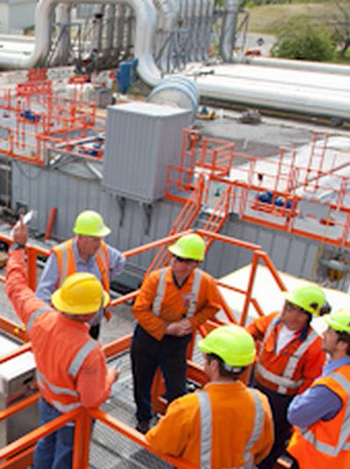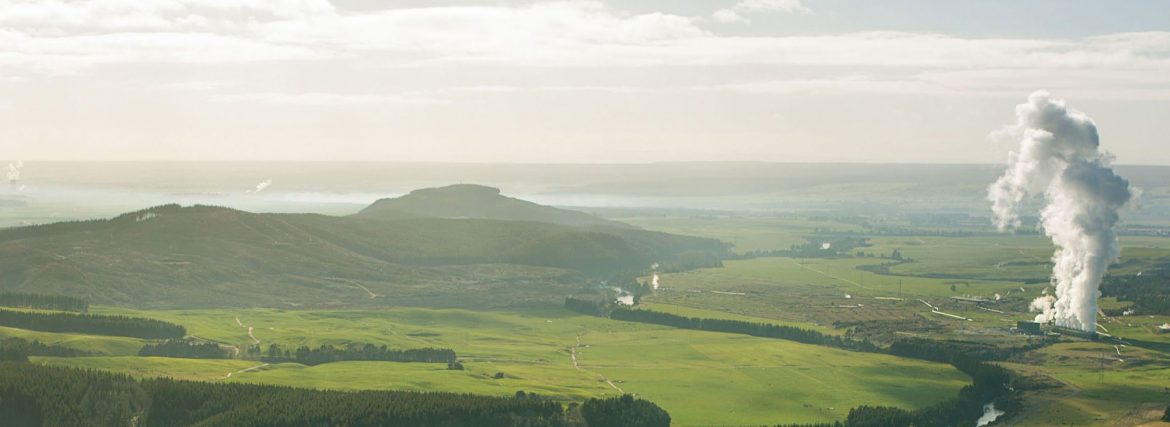Geothermal Energy
An update on the industry in New Zealand
Business View Oceania features a report on the Geothermal Industry from the New Zealand Geothermal Association (NZGA)
Submitted by the New Zealand Geothermal Association (NZGA)
Geothermal is an important energy source in the Western Pacific including the Philippines, Papua New Guinea and Japan. A number of Pacific nations such as Vanuatu, Samoa and the Marianas have the potential to develop geothermal resources. This article examines the current state of one of geothermal energy’s original pioneers: New Zealand.
Market Segments
While New Zealand has ancient and historical uses of geothermal energy, the current geothermal industry arose in the 1950’s and now comprises four segments: high, moderate and low temperature sectors plus a regulatory sector.
The high temperature sector develops geothermal resources for electricity generation and industrial heat processing. Participants in this market include relatively large operator/developers, equipment manufacturers/suppliers, and large construction contractors. In contrast, the moderate temperature sector uses low grade geothermal heat for small-scale, residential and commercial applications such as bathing, space heating and water heating. The insulate sector uses the thermal properties of the earth or ground and surface waters to store and transfer heat via heat pumps for residential and commercial customers. The regulatory sector maintains order in the issuance of extraction permits and environmental protection.
 Over the past 10 years, the NZ geothermal industry has attained sufficient economic mass to support a specialist service industry. The geothermal service sector employs most of the industry’s staff and provides professional & trades training, drilling services, well services, field services, machine/fabrication shops, engineering consulting, reservoir modelling, reservoir software, controls software, construction, regulatory & legal advisors, and scientific research. Sometimes assisted by the Ministry of Foreign Affairs or by New Zealand Trade and Enterprise, this sector increasingly provides services and expertise internationally to clients in Japan, Indonesia, USA, the Philippines, Kenya and Latin America.
Over the past 10 years, the NZ geothermal industry has attained sufficient economic mass to support a specialist service industry. The geothermal service sector employs most of the industry’s staff and provides professional & trades training, drilling services, well services, field services, machine/fabrication shops, engineering consulting, reservoir modelling, reservoir software, controls software, construction, regulatory & legal advisors, and scientific research. Sometimes assisted by the Ministry of Foreign Affairs or by New Zealand Trade and Enterprise, this sector increasingly provides services and expertise internationally to clients in Japan, Indonesia, USA, the Philippines, Kenya and Latin America.
Prominent firms within the service sector include: MB Century (drilling, well services, steamfield engineering), Western Energy Services (well services), Jacobs (geoscience and engineering), Sequent (reservoir software), Solenis (process chemistry-chemicals), Nalco (water chemicals), GNS Science (geoscience and chemical laboratory), Mitchell Daysh (environmental), MTI (engineering), Dobbie Engineering (process engineering), Thorndon Cook (engineering), AECOM (engineering), Upflow (market intelligence), Glucina & Associates (engineering), Flow State Solutions (reservoir modelling software), ProGen (turbine maintenance) and Auckland University – Geothermal Institute (engineering training).
Energy Supply
Geothermal energy contributes 18% (7,660 GWh) to NZ’s annual electricity supply; this exceeds the contributions of wind and solar PV combined (Figure 1). Annual industry income from the wholesale electricity sales recently surged to NZ $539 million due to recent rises in the wholesale prices.
Figure 1: NZ Quarterly Generation by Fuel
High-temperature systems also provide over 5,600 TJs (heat) per year to industrial processes, mainly pasteurisation, drying and evaporating water for the dairy and forest industries. Low-temperature systems supply roughly 8,000 TJs (heat) to residences and commercial customers, and heat pumps now supply another 400 TJs for space heating and cooling.
On a primary energy basis (i.e. before energy conversion losses), geothermal is the largest indigenous energy source in New Zealand, exceeding oil and gas as well as coal.
Geothermal Resources
New Zealand resides on an active plate boundary and contains 129 conductive and convective thermal systems resulting from high crustal heat flows. The 15 high-temperature convection systems in the North Island are thought to result from bodies of magma ponding in the upper 10 km of the crust. Elsewhere, the deep circulation of water along fractures creates the hot springs distributed on both the North and South Islands.
The geothermal industry operates eight high-temperature geothermal fields in the North Island (Table 1). Internationally, New Zealand ranks fifth in terms of geothermal generation.
Table 1: High Temperature Geothermal Fields of the North Island
| Field | Operator | Capacity MWe net | Plants | 1st COD Year |
| Wairakei | Contact Energy Ltd | 352 | 4 | 1958 |
| Rotokawa | Mercury Energy Ltd | 163 | 2 | 1997 |
| Mokai | Tauropaki Trust | 104 | 2 | 1999 |
| Tauhara | Contact Energy Ltd. | 26 | 1 | 2010 |
| Ngatamariki | Mercury Energy Ltd. | 82 | 1 | 2013 |
| Ohaaki | Contact Energy Ltd. | 42 | 1 | 1988 |
| Kawerau A | Ngati Tuwhateroa Geothermal Ventures | 30 | 3 | 1966 |
| Kawerau B | Mercury Energy Ltd | 100 | 1 | 2008 |
| Kawerau C | Eastland Generation Ltd | 33 | 2 | 2008 |
| Ngawha | Top Energy Ltd. | 25 | 2 | 1998 |
| Totals | 957 | 19 |
Technologies Employed
For power generation, geothermal operators employ condensing steam turbines and organic Rankin cycle (“binary”) gen-sets. For direct use applications, operators predominately use heat exchangers linked with kilns and dryers. Heat pump use has exploded over the past five years in residential construction, coupled with commercial “rebuild” applications following the Christchurch 2011 earthquake.
Drilling comprises roughly a third of the cost of high-temperature development. The geothermal industry has specialist drilling contractors, well services, and field services operating in country. Conventional, top drive rigs drill most of the wells but explorers commonly employ mineral or geo-mechanical rigs for slim-hole investigation or monitor wells. Coil tubing units are employed for well work-overs and abandonments. Most drilling uses fresh water or aerated fluids; oil and gas type mud systems are rare.
Growth
 New Zealand’s decarbonisation policy has stimulated innovation and development, particularly in the high-temperature sector. Rising carbon prices have swelled natural gas prices and threaten to economically strand existing baseload thermal plants. In addition, the country seeks to move aggressively into electrifying transportation. Geothermal operators are responding by investing in new capacity on existing fields. Top Energy is currently constructing a third MW binary plant (26 MWe) at Ngawha, Contact Energy is developing a second power station (100 MWe) at Tauhara, and Mercury Energy can potentially add another 20 -30 MWe binary unit at Ngatamariki. In addition, exploration for new development is likely to start at several locations.
New Zealand’s decarbonisation policy has stimulated innovation and development, particularly in the high-temperature sector. Rising carbon prices have swelled natural gas prices and threaten to economically strand existing baseload thermal plants. In addition, the country seeks to move aggressively into electrifying transportation. Geothermal operators are responding by investing in new capacity on existing fields. Top Energy is currently constructing a third MW binary plant (26 MWe) at Ngawha, Contact Energy is developing a second power station (100 MWe) at Tauhara, and Mercury Energy can potentially add another 20 -30 MWe binary unit at Ngatamariki. In addition, exploration for new development is likely to start at several locations.
Geothermal energy competes directly with wind and solar PV technologies. There are no government subsidies or feed-in tariffs to support renewable investments; all energy sources compete on a level tax and price playing field. Greenhouse emissions are managed through an emissions trading scheme which sets the price of carbon discharged to the atmosphere. This charge applies equally to all forms of generation.
Hot Topics and Research
The NZ government funds primary research into geothermal resources and applications through the crown research institutes and universities. In addition, a few firms are funding pilot plants to test new chemical processes such as calcium silicate extraction and hydrogen production. Technologies under investigation include: Lithium extraction from geothermal fluids, chemical controls for mineral scaling, small scale binary plants, non-condensable-gas sequestration, reservoir stimulation, and deep (> 4000 m) drilling.
The Role of the NZGA
The New Zealand Geothermal Association (NZGA) was formed in 1992 as an affiliate of the International Geothermal Association (formed in 1986 as an incorporated society in New Zealand). Geothermalists formed the association to unite the industry and thereby promote and advance geothermal energy in New Zealand and connect internationally.
To this day, the NZGA remains an independent, nongovernmental, non-political and not-for-profit organisation providing information, connections and facilitations to support the use of geothermal energy in New Zealand. The main activities this year include organising a NZ pavilion at the World Geothermal Congress, an annual industry seminar, a quarterly newsletter, a web and social media site, and submissions to government agencies.
The NZGA comprises almost 200 subscriber members, 26 student members, and 25 sponsor companies and institutions. Sponsorships are tiered into gold, silver and bronze categories. Members provide most of the effort supporting NZGA activities; an elected Board of 22 oversees the annual programme and budget.
AT A GLANCE
New Zealand Geothermal Association (NZGA)
What: Organisation promoting geothermal energy
Where: Christchurch, New Zealand
Website: www.nzgeothermal.org.nz



